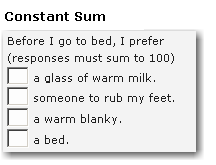Question types detail
Question type formats are detailed below.
Click an item to see its detail. Or choose to [show all] | [hide all].
 Multiple Choice These question types allow you to create one question at a time. Questions may be required and some may ask for another response.
Multiple Choice These question types allow you to create one question at a time. Questions may be required and some may ask for another response.
Individual multiple choice question types include:
- Single Select (vertical)
- Single Select (horizontal)
- Drop Down Menu
- Multiple Select (horizontal)
- Multiple Select (vertical)
 Matrix Matrix question types allow you to create many multiple-choice questions simultaneously, which all use the same response format. We recommend breaking your multiple-choice questions into smaller groups so that your participants can see the column headers. All matrix questions allow you to insert instructions at the time you create the question.
Matrix Matrix question types allow you to create many multiple-choice questions simultaneously, which all use the same response format. We recommend breaking your multiple-choice questions into smaller groups so that your participants can see the column headers. All matrix questions allow you to insert instructions at the time you create the question.
Matrix Multiple Choice
- Single Select (vertical)
- Single Select (horizontal)
- Single Select with Poles (vertical)
- Single Select with Poles (horizontal)
- Drop Down Menu, Single Select (vertical)
- Drop Down Menu, Single Select (horizontal)
- Multiple Select (vertical)
- Multiple Select (horizontal)
- Free Response (10 character limit) (vertical)
- Free Response (10 character limit) (horizontal)
 Free Response Free response question types allow your participant to type in any answer text. Each question type has a limit on the number of characters a participant can type.
Free Response Free response question types allow your participant to type in any answer text. Each question type has a limit on the number of characters a participant can type.
Free Response
- One Line Answer (2 character limit)
- One Line Answer (10 character limit)
- One Line Answer (100 character limit)
- Multiple Line Answer (1000 character limit)
- Essay Answer (8000 character limit)
 Rank Order Participants arrange items in order.
Rank Order Participants arrange items in order.
Participants rank order a series of items.
Note: When the rank order question type is set to required, the internal engine validates that the participant has ranked every item and that all answers use a distinct number between 1 and x (x=total number of answers).

 Constant Sum Participants assign a point value to items in a list. More powerful than rank order.
Constant Sum Participants assign a point value to items in a list. More powerful than rank order.
Participants assign a specified number of points to each item in a series of items.
This type is more powerful than a rank order as a means to assess preference.

 Random Stimulus Assignment: Display 1 of X stimuli to each participant and record the presented stimuli.
Random Stimulus Assignment: Display 1 of X stimuli to each participant and record the presented stimuli.
Use this function to present in a survey question a stimulus selected at random from a group you define. The function records which stimulus was presented for each participant.
This feature makes true experimental designs possible. Combine it with other advanced features such as Question Logic and Random Assignment (between surveys) to create complex online survey designs.
Use this feature to vary presentations of:
- Text--such as descriptions, paragraphs of varying instructions, vignettes.
- Images--of any kind.
- Links--to media such as an audio or video clips.
See also:
Add Random Stimulus Assignment
Logic in Surveys
multiple choice
Individual multiple choice question types include:
- Single Select (vertical)
- Single Select (horizontal)
- Drop Down Menu
- Multiple Select (horizontal)
- Multiple Select (vertical)
matrix
Matrix Multiple Choice
- Single Select (vertical)
- Single Select (horizontal)
- Single Select with Poles (vertical)
- Single Select with Poles (horizontal)
- Drop Down Menu, Single Select (vertical)
- Drop Down Menu, Single Select (horizontal)
- Multiple Select (vertical)
- Multiple Select (horizontal)
- Free Response (10 character limit) (vertical)
- Free Response (10 character limit) (horizontal)
free response
Free Response
- One Line Answer (2 character limit)
- One Line Answer (10 character limit)
- One Line Answer (100 character limit)
- Multiple Line Answer (1000 character limit)
- Essay Answer (8000 character limit)
Additional Question Types
Additional Question Types
Rank Order
Participants rank order a series of items.
Note: When the rank order question type is set to required, the internal engine validates that the participant has ranked every item and that all answers use a distinct number between 1 and x (x=total number of answers).

Constant Sum
Participants assign a specified number of points to each item in a series of items.
This type is more powerful than a rank order as a means to assess preference.

 Multiple Choice These question types allow you to create one question at a time. Questions may be required and some may ask for another response.
Multiple Choice These question types allow you to create one question at a time. Questions may be required and some may ask for another response. Multiple Choice These question types allow you to create one question at a time. Questions may be required and some may ask for another response.
Multiple Choice These question types allow you to create one question at a time. Questions may be required and some may ask for another response. Matrix Matrix question types allow you to create many multiple-choice questions simultaneously, which all use the same response format. We recommend breaking your multiple-choice questions into smaller groups so that your participants can see the column headers. All matrix questions allow you to insert instructions at the time you create the question.
Matrix Matrix question types allow you to create many multiple-choice questions simultaneously, which all use the same response format. We recommend breaking your multiple-choice questions into smaller groups so that your participants can see the column headers. All matrix questions allow you to insert instructions at the time you create the question. Free Response Free response question types allow your participant to type in any answer text. Each question type has a limit on the number of characters a participant can type.
Free Response Free response question types allow your participant to type in any answer text. Each question type has a limit on the number of characters a participant can type. Rank Order Participants arrange items in order.
Rank Order Participants arrange items in order.  Constant Sum Participants assign a point value to items in a list. More powerful than rank order.
Constant Sum Participants assign a point value to items in a list. More powerful than rank order. Random Stimulus Assignment: Display 1 of X stimuli to each participant and record the presented stimuli.
Random Stimulus Assignment: Display 1 of X stimuli to each participant and record the presented stimuli.
